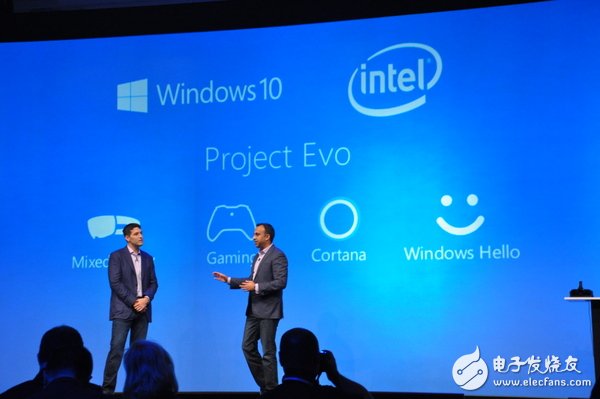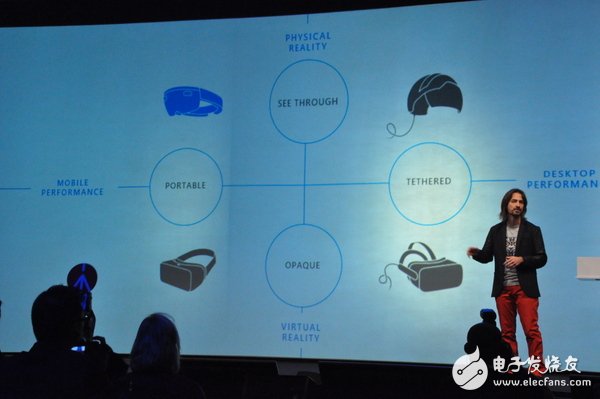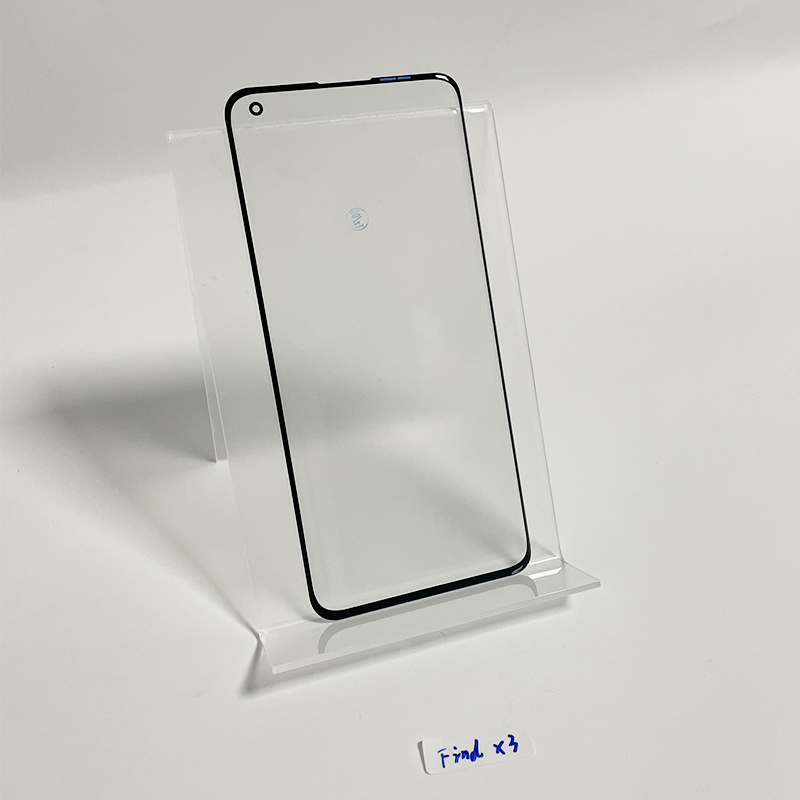Following the announcement that it will join hands with the PC factory to launch the VR headset for Windows 10, Microsoft today (12/8) held the Windows Hardware Engineering Community (WinHEC) conference in Shenzhen, China, to further expose the future of this VR device. Applications, not only can experience PC desktop applications or play 3D movies with VR devices, but also watch live broadcast games, and can also be used to play e-sports and live games.
This year, Microsoft's two WinHEC technical events were held in Shenzhen. Different from the first half of the year, the activities focused on Windows 10 software updates. Today's WinHEC conference is a hybrid of Augmented Reality (AR) and Virtual Reality (VR) devices. Experience. Terry Myerson, global executive vice president of Microsoft Windows and Devices, who is the keynote speaker at today, first mentioned new developments in HoloLens, except in nine countries including the United States, Canada, the United Kingdom, Australia, France, Germany, Ireland, New Zealand, and Japan. It will start selling and will start selling in China next year, providing developers to develop more AR applications or for commercial use.

Terry Myerson also stressed the importance of future integration of Windows 10 and VR devices. He said that the upcoming Windows 10 Creators Update update, which will be released early next year, will enable the PC to fully support 3D and Mixed Reality applications for development. You can also use a variety of VR devices to provide an immersive Windows 10 application experience.
Today, Terry Myerson, executive vice president of Microsoft Windows and Devices, served as the keynote speaker at the conference. He also revealed Microsoft's new strategy for Windows 10 application in VR devices next year.
Following the promise of HP, Dell, Lenovo, Asus and Acer to launch affordable VR devices for Windows 10, Microsoft is also the first to announce the need for PC-side system compatibility with VR hardware, at least with dual-core Intel Core i5 Or i7 CPU (supports Hyper-Threading), with Intel HD Graphics 620 graphics chip (or other DirectX 12-compatible graphics cards), in addition to a minimum of 8GB of memory and 100GB of hard disk space, and supports HDMI 1.4/2.0 or DisplayPort 1.3 interface It can transmit 2K high resolution images (2,880 x 1,440), USB 3.0 Type-A or 3.1 type-c transmission, and Bluetooth 4.0 support.
Microsoft also announced another project with Intel's Project Evo, which will design new PC hardware for mixed-reality applications. It can not only play 4K games with VR devices, but also support Microsoft voice assistant Cotana. And also added Microsoft Windows 10 built-in face recognition function Windows Hello, to enhance device security protection. In addition, Microsoft is working with Qualcomm to create a new Windows 10 device based on the ARM architecture.

There is one more Microsoft Windows 10 compatible VR device. Microsoft announced that it will cooperate with 3Glasses from a Chinese VR device industry. The next-generation VR helmet series, the Blue Platinum S1, which will be launched in the first half of next year, will also support the 3D and hybrid reality experience of the Windows 10 platform. However, the price of one is 499 US dollars, compared to the outside world originally expected the cheapest VR device as long as 299 US dollars, but also a lot higher, positioning will lock higher-end VR applications.
The scene also demonstrates the use of 3Glasses VR helmet to operate the VR-based Windows10 desktop application. The wearer will wear a VR glasses and present a 360-degree virtual room in front of the room. The walls and furniture in this room are not It's just decoration, but it allows you to put the application you want, and can integrate the 2D application on the PC desktop into the 3D virtual space, in addition to viewing your own mail, calendar, browsing photos, and also through Microsoft browser. Edge to watch sports games broadcast, and can play their own 360-degree panoramic film, and can transform real-world objects into 3D virtual images and interact with you in virtual space.
3Glasses from a Chinese VR device industry also demonstrated the use of their latest VR helmet to perform VR-based Windows10 applications, not only to view emails, but also to watch sports games broadcast, or to play their own 360-degree surround movies.

Alex Kipman, inventor of Microsoft HoloLens, said that they are using the Inside-out spatial positioning technology originally used on HoloLens glasses, and they are also used on VR devices, so that VR devices do not need to set up tracking and positioning sensors around the active space, as long as one When the VR device is connected to the PC, it can provide both tracking and spatial positioning effects.
Terry Myerson said the Windows 10 Creators Update released next year will also integrate the gaming experience. In the future, through the combination of Windows 10 and VR devices, not only can be used on PCs, but also such immersive experiences can be used to play 4K high-definition e-sports games, or even for live games. However, he did not disclose the details of the VR device specifications developed in cooperation with other PC vendors. He only mentioned that more VR devices supporting Windows 10 will be launched next year.
Oca Glass provides smartphones with a Touch interface that is critical to their functionality.
Our company provides various brands and models of oca glass displays, such as: Apple, huawei, xiaomi, OPPO, vivo, Samsung, Nokia, OnePlus, etc.
Oca glasses are the most commonly used displays because they produce excellent image quality while consuming low power consumption. Instead of emitting light directly, they use a backlight or reflector to create the image, which makes them easy to read even in direct sunlight. oca glass is energy efficient and relatively safer to handle than crt. Oca glasses are used more efficiently in battery-operated electronics because they consume minimal power.

There are several advantages of OCA (Optically Clear Adhesive) glass:
1. Enhanced Optical Clarity: OCA glass provides excellent optical clarity, ensuring that the display quality is not compromised. It allows for accurate color reproduction and sharpness, making it ideal for high-resolution displays.
2. Improved Touch Sensitivity: OCA glass offers better touch sensitivity compared to other adhesive materials. It enables precise and responsive touch inputs, enhancing the overall user experience.
3. Bubble-Free Installation: OCA glass is designed to provide a bubble-free installation process. The adhesive layer is evenly distributed, minimizing the chances of air bubbles forming between the glass and the display.
4. Thin and Lightweight: OCA glass is thin and lightweight, which helps to maintain the sleekness and portability of electronic devices. It allows for thinner and lighter designs without compromising on durability.
5. High Durability: OCA glass provides excellent resistance to scratches, impacts, and other physical damage. It helps protect the underlying display from accidental drops or everyday wear and tear.
6. Easy Repair and Replacement: In case of damage, OCA glass can be easily replaced without affecting the functionality of the display. The adhesive layer can be removed and replaced, making repairs more convenient and cost-effective.
7. Compatibility with Curved Displays: OCA glass is suitable for curved displays, allowing for seamless integration into devices with curved or flexible screens. It maintains the smoothness of the display surface without causing distortion or visual artifacts.
Overall, OCA glass offers superior optical clarity, touch sensitivity, durability, and ease of repair, making it a preferred choice for various electronic devices such as smartphones, tablets, and televisions.
Screen Glass,Phone Screen Glass,Oca Edge Front Glass,Touch Screen Front Glass
Dongguan Jili Electronic Technology Co., Ltd. , https://www.touchmanufactor.com